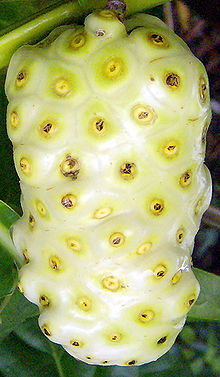Wednesday, December 14, 2016
Sunday, December 11, 2016
Mygov.in : Morinda citrifolia
Mygov.in : Morinda citrifolia: Morinda citrifolia is a tree in the coffee family, Rubiaceae . Its native range extends through Southeast Asia and Australasia , an...
Morinda citrifolia
Morinda citrifolia is a tree in the coffee family, Rubiaceae. Its native range extends through Southeast Asia and Australasia, and the species is now cultivated throughout the tropics and widely naturalized.
English common names include great morinda, Indian mulberry, noni, beach mulberry, and cheese fruit.
Growing habitats
M. Citrifolia, also called "Noni" grows in shady forests, as well as on open rocky or sandy shores. It reaches maturity in about 18 months, then yields between 4 and 8 kg (8.8 and 17.6 lb) of fruit every month throughout the year. It is tolerant of salinesoils, drought conditions, and secondary soils. It is therefore found in a wide variety of habitats: volcanic terrains, lava-strewn coasts, and clearings or limestone outcrops, as well as in coralline atolls. It can grow up to 9 m (30 ft) tall, and has large, simple, dark green, shiny and deeply veined leaves.
The plant bears flowers and fruits all year round. The fruit is a multiple fruit that has a pungent odour when ripening, and is hence also known as cheese fruit or even vomit fruit. It is oval in shape and reaches 10–18 centimetres (3.9–7.1 in) size. At first green, the fruit turns yellow then almost white as it ripens. It contains manyseeds.
M. citrifolia is especially attractive to weaver ants, which make nests from the leaves of the tree.[3] These ants protect the plant from some plant-parasitic insects. The smell of the fruit also attracts fruit bats, which aid in dispersing the seeds. A type of fruit fly, Drosophila sechellia, feeds exclusively on these fruits.
Food
Noni is sometimes called starvation fruit.Despite its strong smell and bitter taste, the fruit is nevertheless eaten as a famine food and, in some Pacific islands, even a staple food, either raw or cooked. Southeast Asians and Australian Aboriginesconsume the fruit raw with salt or cook it with curry. The seeds are edible when roasted.
In Thai cuisine, the leaves (known as bai-yo) are used as a green vegetable and the fruit (luk-yo) is added as a salad ingredient to some versions of somtam.
Nutrients and phytochemicals
M. citrifolia fruit powder contains carbohydrates and dietary fibre in moderate amounts. These macronutrients evidently reside in the fruit pulp, as M. citrifoliajuice has sparse nutrient content. The main micronutrients of M. citrifolia pulp powder include vitamin C, niacin (vitamin B3), iron and potassium.Vitamin A,calcium and sodium are present in moderate amounts. When M. citrifolia juice alone is analyzed and compared to pulp powder, only vitamin C is retained in an amount (34 mg per 100 gram juice) that is 64% of the content of a raw navel orange (53 mg per 100 g or 89% of the Daily Value).Sodium levels in M. citrifolia juice (about 3% of Dietary Reference Intake, DRI) are high compared to an orange, and potassium content is moderate.
M. citrifolia fruit contains a number of phytochemicals, including lignans, oligo- andpolysaccharides, flavonoids, iridoids, fatty acids, scopoletin, catechin, beta-sitosterol, damnacanthal, and alkaloids.Although these substances have been studied for bioactivity, current research is insufficient to conclude anything about their effects on human health.[1] These phytochemicals are not unique to M. citrifolia, as they exist in various plants.[12]
Traditional medicine
Green fruit, leaves, and root/rhizomes might have been used in Polynesian cultures as a general tonic, in addition to its traditional place in Polynesian culture as a famine food.
In traditional Chinese medicine, the roots, known as ba ji tian, have been used for abdominal pain, impotence, andmenstrual disorders. Although Morinda is considered to have biological properties in traditional medicine, there is no confirmed evidence of clinical efficacy for any intended use.
Consumer uses
Morinda bark produces a brownish-purplish dye that may be used for making batik. In Hawaii, yellowish dye is extracted from its roots to dye cloth.A variety of beverages (juice drinks), powders (from dried ripe or unripe fruits), cosmetic products (lotions, soaps), oil (from seeds), leaf powders (for encapsulation or pills) have been introduced into the consumer market.
Gallery
Thursday, December 8, 2016
Mygov.in : JAYLALITHAA (1948 - 2016)
Mygov.in : JAYLALITHAA (1948 - 2016): 1. Jayalalithaa's mother worked as an actress in local drama companies and Tamil cinema. She followed in her mother's footsteps...
JAYLALITHAA (1948 - 2016)
1.
Jayalalithaa's mother worked as an actress in local drama companies and Tamil cinema. She followed in her mother's footsteps, first as a child actor. At the age of 15, she played a leading role in the Kannada film Chinnada Gombe, which became a runaway success.
2.
Jayalalithaa was professionally trained in classical music, western classical piano, and various forms of classical dance, including Bharatanatyam, Mohiniattam, Manipuri and Kathak.
3.
Jayalalithaa was be referred to as Puratchi Thalaivi (Revolutionary Leader) but she was called 'Ammu' by close family members and co-stars.
4.
The first time she starred alongside M G Ramachandran, one of Tamil Nadu's greatest movie stars and a former chief minister of the state, was in the Tamil film 'Aayirathil Oruvan.'
6.
The peak of Jayalalithaa's film career occurred between 1965 and 1980. During this period, she was one of India's highest-paid actresses, and acted in over 140 films, 120 of which were blockbusters.
7.
It is said that her male co-stars did not object when the film's story revolved around and was driven by the female character played by Jayalalithaa.
8.
During the year 1960s and 1970s, she starred opposite M G Ramachandran in a number of successful films. This forged a bond between the two, which led MGR to introduce her to politics when he was chief minister of Tamil Nadu. Jayalalithaa joined MGR's All-India Anna Dravida Munnetra Kazhagam in 1982, and was appointed the party's propaganda secretary the following year.
9.
She represented the AIADMK in the Rajya Sabha between 1984 and 1989. She was elected after MGR wanted her in New Delhi for her fluency in English and knowledge of several languages.
10.
When MGR died in 1987, he left no clear political heir. AIADMK descended into chaos over his legacy. Jayalalithaa competed with his widow Janaki for control of the party, which eventually split into two major factions, one behind each woman.
11.
In 1989, Jayalalithaa was elected to the Tamil Nadu Legislative Assembly. She became the first woman to be appointed Leader of the Opposition. In the same year, the two factions of AIADMK merged and unanimously accepted Jayalalithaa as their leader.
12.
During her term as Leader of the Opposition, DMK MLAs molested Jayalalithaa and nearly disrobed her while the house was in session. Media coverage of her emerging from the assembly in a torn saree, and her own comparison of the ordeal to Draupadi's cheerharan, won immense sympathy from the public.
13.
In 1991, Jayalalithaa became the first female(and the youngest) chief minister of Tamil Nadu to serve a full term.
14.
The obscenely lavish wedding of Jayalalithaa's 'foster son' Sudhagaran holds the record for being the largest wedding banquet (incurring taxpayers a massive Rs 10 crore bill), attended by over 1,50,000 guests.
15.
Unfortunately, the feat which won her a place in the Guinness Book of World Records proved to be her downfall in the 1996 elections.
16.
Jayalalithaa returned to power in 2001, but her second term as chief minister was cut short when the Supreme Court ruled that she could not hold office while criminal cases were pending against her. She had been convicted on corruption charges in the Pleasant Stay Hotel case, though she was later acquitted and was reinstated as CM in 2003.
17.
Jayalalithaa was sworn in as chief minister for the third time in 2011. But in 2014, she was sentenced to four years in jail in a disproportionate assets case. As a result, she became the first Indian chief minister to be disqualified from her post and the legislative assembly.
Subscribe to:
Comments (Atom)




